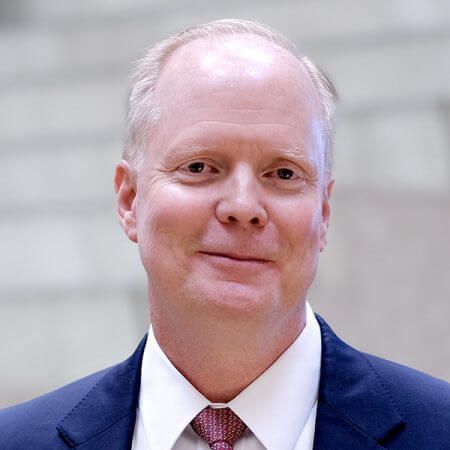
Thornburg PMs discuss important topics impacting the municipal bond market, including supply and demand, infrastructure spending and cyber security.
The Supply and Demand Effect on the Muni Market
David Ashley: You know, infrastructure always seems to be a perennial topic but strangely enough every year roads are paved, and there’s a ton of issuance this year for airports already. The runways at airports are paved. The bridges are, are, they’re operable, you know, if they need to be fixed, they get fixed. Well, this is an interesting package that got passed. I think, you know, the funding will be great. You can do more than maybe you usually do but I think the infrastructure play is, is a little overplayed in my, my estimation.
Dominic Alto: Hi. Welcome to another episode of “Away from the Noise”, Thornburg Investment Management’s podcast on key investment topics. My name is Dominic Alto. I’m client portfolio manager at Thornburg, and joining me today is Eve Lando, John Bonnell and Dave Ashley, portfolio managers on our municipal strategies. So, to begin today I’d like to start with you Eve and discuss the infrastructure bill that was just passed by the Senate and specifically I’m interested in any key takeaways or highlights that you saw or what type of impact you would expect this to have on the municipal market.
Eve Lando: The bill authorized about 1 trillion in federal and prescribed to spending over 5 years. This is actually doubling what the federal government was planning to spend in infrastructure prior to this, new legislature. Now, this is a significant increase by any stretch of imagination, although some lament it’s not enough, while others complain that it will be a repeat of shovel ready event of 2009, with very little show for it. For us key take away is that the supply of muni bonds is most likely to go up, and overall, the presentation of this bill is a positive for muni market. On the supply side we’ll have more issuance from state and local governments. From a demand side, it will most likely be paid for through tax increases, so there’ll be increase in, need for tax free income.
Dominic Alto: Thank you Eve. and with that I’d like to turn the conversation to John. John, I’d be interested in your opinion on just that supply and demand effect, specifically, I know that there’s still questions about the financing of these projects, but how do you see this playing out broadly in the market.
John Bonnell: Dominic, as, as you know the supply has just not kept up with demand here lately and I, I agree with what Eve just said that, you know, that the bill that is making its way through right now, more than likely will increase the supply in our market. The tax-exempt market. but what is yet to be determined is how much of that is gonna be financed in the, in the muni market as opposed to the taxable market. I think it’s yet to be determined, you know, exactly how much, but many, many of the projects that they increase the funding for are things like road and bridges, highways, airports, ports, gosh, water and sewer type projects. These are, these are entities that are normally financed very efficiently in the tax exempt market so my, my guess is that a lot of it will come in the taxes and market, and that the supply, right, at least with the market conditions that we have right now, would easily be absorbed.
Dominic Alto: You know as a follow-up question, you mention financing mechanisms, and specifically the Build America Bond program or BABs as, as they’re known. I’m wondering if you could provide just a little bit of background on that program for anybody who wasn’t invested in the municipal market prior to the financial crisis.
John Bonnell: Well recall Dominic that when the BABs came out, that was right after the financial crisis of ’08. That was a time when we didn’t have a lot of liquidity in the market. Things had kinda frozen up, and basically what it was, it was just a different way for the federal government to subsidize state and local borrowers cost of issuing debt, so instead of borrowers issuing tax-exempt debt, they issued taxable debt and the federal government subsidized the interest rate that they had to pay on the bonds, back to the issuers. So what it did was it, it, it opened up access to state and local borrowers to a much larger and much more liquid market. this bill did not address whether they would bring the BABs program back or not. Didn’t address several things that have a direct impact on municipal investors, BABs being one of them and, and as you know, there are some, politicians that have been talking about BABs for quite a while. what I would say is, you know, the tax-exempt market generally speaking, has been a very efficient way for issuers to raise capital. sure, there are times in the market where liquidity is less than it otherwise might be, but honestly that’s true in the taxable market as well. if they did bring the BABs program back, more than likely, you know, the, the traditional tax-exempt supply would be lower, in our market, and of course as a tax-exempt buyer, I’m obviously biased. I, I’d prefer to see it in our side of the market, where we are starved for, for product. Again, the, the supply just has not kept up with demand recently.
Dominic: Dave, I’d like to ask you a question specifically about the Build America Bond program. One of the goals was to expand ownership of municipal bonds and specifically international foreign buyers. Is that something that’s ever materialized? Did those buyers ever show up?
David Ashley: I think we’ve already seen that to a certain extent when you look at, you know, worldwide rates, I mean you still look attractive especially from, a credit perspective versus maybe what they’re lookin’ at in the, in the corporate market, or even some soveigns. If we think back to 2008, 2009, our prevailing rates were probably, I think these, and most BABs are issued for in, in the 5 and 6 percent range. You know and, and subsidy was very important for the issuer back in that timeframe, but you forward to today and issuers can almost borrow for free, so I think the BABs might have to have like a slightly different structure or something to make them interesting to issuers just because you can already borrow for free so the subsidy really isn’t, you know, that important anymore. The global reach, you know, the, the larger investor base being, being taxable definitely, you know, offers some other benefits, besides the subsidy but in a broader buyer base etc. but I think to make them effective and, and useful for, you know, issuers in the U.S. it’d have to, we’d either have to see a rise in rates to make the subsidy worthwhile.
Dominic: So, thank you Dave. You know, this conversation about Build America Bonds, or BABs, really brings to mind what is happening in the municipal market in terms of taxable issuance overall over the last 18 months. is that something that has grown significantly?
David Ashley: I mean, you know, there’s always the ratio argument if you look at the same credits and then on an after-tax basis you can get a, you know, a better yield overall. I mean that’s a win, so I mean there’s, there’s always gonna be people who look between, you know, crossover bars who are always looking between, the two asset classes. So sure, yeah, I think that’s, that’s a definite possibility. but I think right now, I mean we’re still, you know, we’re kinda like, its credation’s a zero so what you’re picking up is relative value so maybe pick up an extra 10 basis or 15 basis points of after-tax income, but you’re still kinda like playing in a very, very narrow pool of, of yield to begin with.
Dominic Alto: And the taxable, issuance that we saw over the last 18 months, you know, my understanding was that was always kind of a small segment of the market. Has that grown or expanded, or is it still, you know, the, kinda corners of the market that’s still, still, use that taxable space?
Next Speaker: No, for sure, it, it’s definitely, grown quite a bit but with absolute yields being so low on, on the taxable side, and the gen, and I think the catalyst behind that was what’s the what’s the loss on advanced fundings on, on the tax-exempt side. If you can’t advance refund on the tax-exempt side anymore, but absolute levels are still low. it’s very attractive to, you know, to refund your debt in the, in the taxable market. So yes, we’ve seen quite a bit of perhaps your non traditional issuers like you saw with the BABs, you saw like, you know, higher ed, some hospitals, some, you know, some well-known names that, you know, folks overseas would know, foreign buyers would know but now you’ve, it’s kind of become more broad-based across all sectors.
Dominic Alto: Eve, I have a question for you regarding ESG. there’s a lot of aspects to this bill. Was there anything that jumped out at you that is ESG specific for muni investors?
Eve Lando: yes. Environmental aspects are addressed throughout this bill. different provisions are peppered through different, sections, be it railroads, be it powerlines, water, and sewer upgrades, infrastructure upgrades overall have a very, heavy slant here to, to make sure that there is a provision and their money set aside, to upgrade systems and make them more environmentally sound. what caught my eye was, the electrical vehicle provision, close to 8 billion, and it is specifically for electric school buses to be provided to school districts and as we know transportation for school districts is one of the largest expenditures, so this will definitely be a positive for a sector also while accomplishing, en, environmental, goal. also, another interesting, E from ESG Aspect, you could see in water upgrades. the prominent was the bill, nearly 55 billion is set aside for water upgrades, and replacement of existing unsafe service lines and pipes, unfortunately in the past couple of years we’ve seen water issues come up and definitely this would, work out very well in our market to, to create kind of green bonds issued with leveraging this provision to supply, to supply municipalities, local governments, authorities with money necessary for, environmental upgrades. So definitely see that throughout, throughout this 1 trillion package. it is not as much as the initial conversations were about, but it is plentiful, for, muni issuers to, to kind of get on and, and, and leverage those. lastly the 21 billion for environmental remediation, so that is spelled out exactly that this would be spent on green projects, that will be dedicated to cleaning up, existing either already designated superfund, localities or, brown field side etc. So plenty, of ESG, issuance to look for but, uh.
Dominic Alto: Eve, you’ve, we’ve talked a lot about specifics of this deal. I’m interested in your opinion on whether or not a trillion dollars of the size of this package is going to be enough to address the needs that we have in this country.
Eve Lando: That is a big question. I cannot, reply definitely that this is exactly a price tag to put on to upgrade all of the infrastructure all over the U.S., but I am very hopeful that the result of this will be different than what we’ve seen in ’09 when only a fraction of money designated have been used. Only a fraction of projects came through so I guess wait and see, and we’re looking forward to the end of September to see if this bill will become a law eventually.
Dominic Alto: John, I know we’ve talked specifics about the bill. Given the $1 trillion price tag, I’m interested in your opinion on whether or not this is enough to satisfy the infrastructure needs we have in this country.
John Bonnell: I do think it is just a down payment. I mean without a doubt it is a step in the right direction, but even, even the, the increase, even though it roughly doubled the funding, you gotta remember that that is spread out over 5 years. I mean it’s not all at once. It’s, it’s over the next 5 years and projects have already been identified that as you can imagine are well in excess of the additional funding amount already. So, we know there’s always something else that needs to be done. There’s always something that, was deferred in the past that, you know, at some point it’s gonna have to be paid for. One of the things outside of what we’ve already talked about, which was that it’s silent on the advanced refunding ability, I think that is something that they’re gonna need to address but I, I also hope that they address a more sustainable funding source for longer term projects. It goes back to the point Eve was making, you know, about roads, highways and bridges. No. 1, cars are way more efficient now than they used to be. No. 2, electric vehicles are becoming more and more popular, and expected to get more so and so the, the traditional source of funding for that was always the gas tax and you can imagine that, you know, people gonna need as many gallons of gas or diesel in these type of vehicles and so the, the funding, and it’s not sustainable the way it’s set up now. And at some point things like that are just gonna have to be addressed.
Dominic Alto: Dave, the question I have for you is, with a trillion-dollar price tag, is there anything in here that is missing or that left you wanting? Maybe more importantly how do we pay for something like this?
David Ashley: I wanna take just a slightly different tact from Eve and John. You know, infrastructure always seems to be a perennial topic but strangely enough every year roads are paved, and there’s a ton of issuance this year for airports already. The runways at airports are paved. The bridges are, are, they’re operable, you know, if they need to be fixed, they get fixed. Well, this is an interesting package that got passed. I think, you know, the funding will be great. You can do more than maybe you usually do but I think the infrastructure play is, is a little overplayed in my, my estimation. I mean, things get done when they need to get done. There’s always needs, but the U.S. is a very large country. A lot of infrastructure so you’re never gonna have everything brand new in the U.S. at the same time.
Dominic Alto: So, Eve, let me ask you. Is this a step in a right direction? And how do we fund a bill like this with a trillion-dollar price tag.
Eve Lando: No, absolutely. And this is something we talk on desk all the time, and one of the aspects is the public transportation, price tag that’s included in this bill. it is 39 billion and this is in addition to roughly 20 billion that had been spent since March 2020, and we were talking about how many things are going to disrupt the way we transport people and goods right now, whether it’s EVs, different kinds of roads, so perhaps spending, nearly one third of this infrastructure, bill on, on something that is not up to date, or is going through technological changes, might not be as efficient as one would like to see, and public transportation spending has been a weak spot for many reasons in the U.S., so we’re just watching how that debate, will, will play out.
Dominic Alto: Eve, something else that has garnered a lot of headlines are both cyberattacks and ransomware. Is this something that the team is looking at, and are there any provision in the bill that provide assistance?
Eve Lando: Of course. cyber security risk, is definitely on, on our radar. It is one of the criteria here at Thornburg that we use in the signing and ESG ranking for all of our muni holdings. there is about 60 billion, broadly defined as broadband financing. In my understanding portions of that, money will be earmarked and spent on making sure that state and local governments have enough, knowledge, ability, have the right systems, to address that and address that not piecemeal but perhaps there will be some centralized way of, dealing with the, ransom attacks.
Dominic Alto: John, talking about cyberattacks, is there anything that’s really caught your attention about what has happened recently to municipalities?
John Bonnell: I think what caught my attention was just the number of cyberattacks that we have seen, impacting both municipalities and corporations and, and the, the consequences that can occur when that happens. It was very surprising to me to see how vulnerable all these systems are and again it just, it highlights the fact that there’s certain essential systems that we need to make sure are very resilient, to keep the economy going.
Dominic Alto: So Dave, with the increase in cyberattacks, how do you account for that when doing credit research?
David Ashley: To John’s point, I mean the numbers have increased. You see more of the headlines about this company or that, that entity has been breached. I think on a total aggregate level it’s probably very, very negligible still, but maybe we just don’t hear about them. That could be a possibility too. If you’re looking for settlements, why do they keep the headline news down? But I think in general it’s, you know, you just have to be careful with what you’re picking. It’s a factor to, to price in but not to get an evaluation right now but, you know, we, we look at a lot of different variables when we price bonds, and unfortunately a lot of those variables aren’t getting priced right now but we would love to get paid for a little bit more of that risk but right now it’s just not possible but yes, it is a variable that we look at to at least get a little compensation for.
Dominic Alto: So, Dave, let me ask, what impact will this have on credit generally, or maybe more specifically what impact would it have on a transportation system like MTA in New York?
Next Speaker: Well, I mean the market kinda runs independent I think of all this stuff. I mean in general credit quality would, would be temporarily improved with more federal funding. But that’s an obvious statement. Some states haven’t had to issue cash flow notes like Texas. You know, usually they issue cash flow notes. they haven’t had to do that this year. But what’s an interesting example is MTA in New York. If you look at their CARES Act funding, the, the funding that’s gonna come through some of these Budget Reconciliation Act, infrastructure, etc. I mean they’re, they’re still running deficits, without labor concessions and without fare increases. So I mean the amount of money we’re talking about here is is just extraordinary and, you know, the MTA’s probably already at 48, $49 billion in debt, even though these entities might be flushed today, it, it still may not be enough to meet their needs without other factors being adjusted.
Dominic Alto: John, let me ask your opinion. Is this a net positive for the market?
John Bonnell: Overall, I mean this infrastructure bill is a positive for state and local governments, and, and for the economy, even though it might just be a step that, of, of many that need to be taken in the right direction, but I think overall, state and local government credit quality is still extremely strong. I mean the real problems that exist, you can count, you know, on your, your hands. They, they exist and, and clearly the muni market is a credit market. It’s not a rate, only market as it once was thought of but I think overall things, things look pretty good from the credit side.
Dominic Alto: So, I think that’s a, a great place to end, you know, that John doesn’t know if he’s a bond manager ’cause he’s a pessimist or if he’s a pessimist because he’s a bond manager.
With that I’d to thank Eve, John and Dave for joining me, and I would like to thank all of you for listening. If you enjoyed this podcast, you can find others on investing topics ranging from municipal bonds to emerging markets on thornburg.com/podcast as well as apple podcast where you can rate, subscribe and review us. So please join us for the next episode of Away from the Noise. Until then, we wish you profitable investing.
Important information
The views expressed are subject to change and do not necessarily reflect the views of Thornburg Investment Management Incorporated. This information should not be relied upon as a recommendation or investment advice and is not intended to predict the performance of any investment or market.
This is not a solicitation or offer for any product or service, nor is it a complete analysis of every material fact concerning any market, industry, or investment. Data has been obtained from sources considered to be reliable. The Thornburg makes no representations as to the completeness or accuracy of such information and has no obligation to provide updates or changes. Thornburg does not accept any responsibility and cannot be held liable for any person’s use of or reliance on the information and opinions contained herein.
Investments carry risks, including possible loss of principal.
Outside the United States
This is directed to INVESTMENT PROFESSIONALS AND INSTITUTIONAL INVESTORS ONLY and is not intended for use by any person or entity in any jurisdiction or country where such distribution or use would be contrary to the laws or regulations applicable to their place of citizenship, domicile, or residence.
Thornburg is regulated by the U.S. Securities and Exchange Commission under U.S. laws, which may differ materially from laws in other jurisdictions. Any entity or person forwarding this to other parties takes full responsibility for insuring compliance with applicable securities laws in connection with its distribution.
For United Kingdom, this communication is issued by Thornburg Investment Management Limited, TIM Limited, and approved by Robert Quinn Advisory LLP, which is authorized and regulated by the U.K. Financial Conduct Authority, FCA. TIM Limited is an appointed representative of Robert Quinn Advisory LLP.
This communication is exclusively intended for persons who are professional clients or eligible counterparties for the purposes of the FCA rules and other persons should not act or rely on it. This communication is not intended for use by any person or entity in any jurisdiction or country where such distribution or use would be contrary to local law or regulation.
Discover more about:
More Insights

Thornburg Investment Income Builder Fund – 1st Quarter Update 2025

Taiwan Semi, Tencent, and Other “Quality” Favorites

Investor Spotlight: The Municipal Bond Tax Exemption

Thornburg’s History of Recognition

International Equity: The Power of Global Diversification




